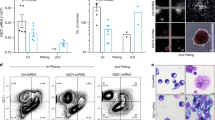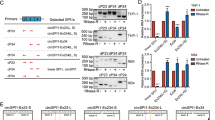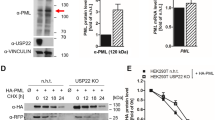Abstract
The transcription factor PU.1 is essential for terminal myeloid differentiation, B- and T-cell development, erythropoiesis and hematopoietic stem cell maintenance. PU.1 functions as oncogene in Friend virus-induced erythroleukemia and as tumor suppressor in acute myeloid leukemias. Moreover, Friend virus-induced erythroleukemia requires maintenance of PU.1 expression and the disruption of p53 function greatly accelerates disease progression. It has been hypothesized that p53-mediated expression of the p21Cip1 cell cycle inhibitor during differentiation of pre-erythroleukemia cells promotes selection against p53 function. In addition to the blockage of erythroblast differentiation provided by increased levels of PU.1, we propose that PU.1 alters p53 function. We demonstrate that PU.1 reduces the transcriptional activity of the p53 tumor suppressor family and thus inhibits activation of genes important for cell cycle regulation and apoptosis. Inhibition is mediated through binding of PU.1 to the DNA-binding and/or oligomerization domains of p53/p73 proteins. Lastly, knocking down endogenous PU.1 in p53 wild-type REH B-cell precursor leukemia cells leads to increased expression of the p53 target p21Cip1.
This is a preview of subscription content, access via your institution
Access options
Subscribe to this journal
Receive 50 print issues and online access
$259.00 per year
only $5.18 per issue
Buy this article
- Purchase on Springer Link
- Instant access to full article PDF
Prices may be subject to local taxes which are calculated during checkout


Similar content being viewed by others
References
Back J, Dierich A, Bronn C, Kastner P, Chan S . (2004). PU.1 determines the self-renewal capacity of erythroid progenitor cells. Blood 103: 3615–3623.
Behre G, Whitmarsh AJ, Coghlan MP, Hoang T, Carpenter CL, Zhang DE et al. (1999). c-Jun is a JNK-independent coactivator of the PU.1 transcription factor. J Biol Chem 274: 4939–4946.
Benard J, Douc-Rasy S, Ahomadegbe JC . (2003). TP53 family members and human cancers. Hum Mutat 21: 182–191.
Britschgi C, Rizzi M, Grob TJ, Tschan MP, Hügli B, Reddy VA et al. (2006). Identification of the p53 family-responsive element in the promoter region of the tumor suppressor gene hypermethylated in cancer 1. Oncogene 25: 2030–2039.
Chen WY, Wang DH, Yen RC, Luo J, Gu W, Baylin SB . (2005). Tumor suppressor HIC1 directly regulates SIRT1 to modulate p53-dependent DNA-damage responses. Cell 123: 437–448.
Cheng T, Rodrigues N, Shen H, Yang Y, Dombkowski D, Sykes M et al. (2000). Hematopoietic stem cell quiescence maintained by p21cip1/waf1. Science 287: 1804–1808.
Cory S, Huang DC, Adams JM . (2003). The Bcl-2 family: roles in cell survival and oncogenesis. Oncogene 22: 8590–8607.
Goldschneider D, Million K, Meiller A, Haddada H, Puisieux A, Benard J et al. (2005). The neurogene BTG2TIS21/PC3 is transactivated by DeltaNp73alpha via p53 specifically in neuroblastoma cells. J Cell Sci 118: 1245–1253.
Houston IB, Huang KJ, Jennings SR, DeKoter RP . (2007). PU.1 immortalizes hematopoietic progenitors in a GM-CSF-dependent manner. Exp Hematol 35: 374–384.
Inoue K, Roussel MF, Sherr CJ . (1999). Induction of ARF tumor suppressor gene expression and cell cycle arrest by transcription factor DMP1. Proc Natl Acad Sci USA 96: 3993–3998.
Iwasaki H, Somoza C, Shigematsu H, Duprez EA, Iwasaki-Arai J, Mizuno S et al. (2005). Distinctive and indispensable roles of PU.1 in maintenance of hematopoietic stem cells and their differentiation. Blood 106: 1590–1600.
Jundt F, Kley K, Anagnostopoulos I, Schulze Probsting K, Greiner A, Mathas S et al. (2002). Loss of PU.1 expression is associated with defective immunoglobulin transcription in Hodgkin and Reed-Sternberg cells of classical Hodgkin disease. Blood 99: 3060–3062.
Kelley LL, Hicks GG, Hsieh FF, Prasher JM, Green WF, Miller MD et al. (1998). Endogenous p53 regulation and function in early stage Friend virus-induced tumor progression differs from that following DNA damage. Oncogene 17: 1119–1130.
McKercher SR, Torbett BE, Anderson KL, Henkel GW, Vestal DJ, Baribault H et al. (1996). Targeted disruption of the PU.1 gene results in multiple hematopoietic abnormalities. EMBO J 15: 5647–5658.
Melino G, De Laurenzi V, Vousden KH . (2002). p73: friend or foe in tumorigenesis. Nat Rev Cancer 2: 605–615.
Miyake N, Brun AC, Magnusson M, Miyake K, Scadden DT, Karlsson S . (2006). HOXB4-induced self-renewal of hematopoietic stem cells is significantly enhanced by p21 deficiency. Stem Cells 24: 653–661.
Moll UM, Slade N . (2004). p63 and p73: roles in development and tumor formation. Mol Cancer Res 2: 371–386.
Moreau-Gachelin F . (2006). Lessons from models of murine erythroleukemia to acute myeloid leukemia (AML): proof-of-principle of co-operativity in AML. Haematologica 91: 1644–1652.
Moreau-Gachelin F, Wendling F, Molina T, Denis N, Titeux M, Grimber G et al. (1996). Spi-1/PU.1 transgenic mice develop multistep erythroleukemias. Mol Cell Biol 16: 2453–2463.
Munroe DG, Peacock JW, Benchimol S . (1990). Inactivation of the cellular p53 gene is a common feature of Friend virus-induced erythroleukemia: relationship of inactivation to dominant transforming alleles. Mol Cell Biol 10: 3307–3313.
Nutt SL, Metcalf D, D'Amico A, Polli M, Wu L . (2005). Dynamic regulation of PU.1 expression in multipotent hematopoietic progenitors. J Exp Med 201: 221–231.
Pluta A, Nyman U, Joseph B, Robak T, Zhivotovsky B, Smolewski P . (2006). The role of p73 in hematological malignancies. Leukemia 20: 757–766.
Prasher JM, Elenitoba-Johnson KS, Kelley LL . (2001). Loss of p53 tumor suppressor function is required for in vivo progression of Friend erythroleukemia. Oncogene 20: 2946–2955.
Rimmele P, Kosmider O, Mayeux P, Moreau-Gachelin F, Guillouf C . (2007). Spi-1/PU.1 participates in erythroleukemogenesis by inhibiting apoptosis in cooperation with Epo signaling and by blocking erythroid differentiation. Blood 109: 3007–3014.
Sherr CJ, Weber JD . (2000). The ARF/p53 pathway. Curr Opin Genet Dev 10: 94–99.
Acknowledgements
We thank Drs C Prives, A Villunger and M Loeffler for providing plasmids. This work was supported by grants from the National Institutes of Health DK49886 and AI49165, The Stein Endowment Fund and The Joyce Klein Stock Gift (to BET); the Swiss National Science Foundation 3100A0-112385 (to MFF) and 3100A0-118276 (to MPT), the Marlies-Schwegler Foundation and the Bernese Foundation of Cancer Research (to MFF). MPT is a recipient of fellowships from the Swiss National Foundation (84NP-057502), the Swiss Federation against Cancer (no. BIL OCS–01198-09-2001) and the Bernese Cancer League.
Authors' contribution: MPT performed project design, collection and analysis of all data, and manuscript writing. VAR performed in vitro protein interaction assays and reviewed manuscript. RA and GA performed in vivo protein interaction and RNA interference assays and reviewed manuscript. BET and MFF contributed toward project planning and design, data analysis and manuscript writing.
Author information
Authors and Affiliations
Corresponding author
Additional information
This is publication 18417-MEM from The Scripps Research Institute.
Rights and permissions
About this article
Cite this article
Tschan, M., Reddy, V., Ress, A. et al. PU.1 binding to the p53 family of tumor suppressors impairs their transcriptional activity. Oncogene 27, 3489–3493 (2008). https://doi.org/10.1038/sj.onc.1211004
Received:
Revised:
Accepted:
Published:
Issue Date:
DOI: https://doi.org/10.1038/sj.onc.1211004
Keywords
This article is cited by
-
PU.1 supports TRAIL-induced cell death by inhibiting NF-κB-mediated cell survival and inducing DR5 expression
Cell Death & Differentiation (2017)
-
Oncopig Soft-Tissue Sarcomas Recapitulate Key Transcriptional Features of Human Sarcomas
Scientific Reports (2017)
-
PC-TraFF: identification of potentially collaborating transcription factors using pointwise mutual information
BMC Bioinformatics (2015)
-
The anti-apoptotic gene BCL2A1 is a novel transcriptional target of PU.1
Leukemia (2010)



